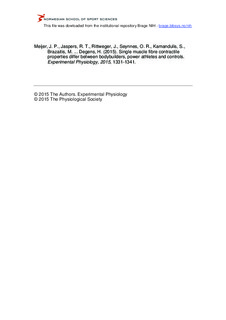| dc.contributor.author | Meijer, J.P | |
| dc.contributor.author | Jaspers, R.T. | |
| dc.contributor.author | Rittweger, Jörn | |
| dc.contributor.author | Seynnes, Olivier R. | |
| dc.contributor.author | Kamandulis, Sigitas | |
| dc.contributor.author | Brazaitis, M. | |
| dc.contributor.author | Skurvydas, A. | |
| dc.contributor.author | Pisot, Rado | |
| dc.contributor.author | Šimunič, Boštjan | |
| dc.contributor.author | Narici, Maco V. | |
| dc.contributor.author | Degens, Hans | |
| dc.date.accessioned | 2016-02-18T10:22:25Z | |
| dc.date.available | 2016-02-18T10:22:25Z | |
| dc.date.issued | 2015-11-17 | |
| dc.identifier.citation | Experimental Physiology. 2015, 100, 1331–1341. doi:10.1113/EP085267 | nb_NO |
| dc.identifier.uri | http://hdl.handle.net/11250/2379482 | |
| dc.description | © 2015 The Authors. Experimental Physiology © 2015 The Physiological Society | nb_NO |
| dc.description.abstract | What is the central question of this study?
Do the contractile properties of single muscle fibres differ between body-builders, power athletes and control subjects?
•What is the main finding and its importance?
Peak power normalized for muscle fibre volume in power athletes is higher than in control subjects. Compared with control subjects, maximal isometric tension (normalized for muscle fibre cross-sectional area) is lower in body-builders. Although this difference may be caused in part by an apparent negative effect of hypertrophy, these results indicate that the training history of power athletes may increase muscle fibre quality, whereas body-building may be detrimental.
We compared muscle fibre contractile properties of biopsies taken from the vastus lateralis of 12 body-builders (BBs; low- to moderate-intensity high-volume resistance training), six power athletes (PAs; high-intensity, low-volume combined with aerobic training) and 14 control subjects (Cs). Maximal isotonic contractions were performed in single muscle fibres, typed with SDS-PAGE. Fibre cross-sectional area was 67 and 88% (P < 0.01) larger in BBs than in PAs and Cs, respectively, with no significant difference in fibre cross-sectional area between PAs and Cs. Fibres of BBs and PAs developed a higher maximal isometric tension (32 and 50%, respectively, P < 0.01) than those of Cs. The specific tension of BB fibres was 62 and 41% lower than that of PA and C fibres (P < 0.05), respectively. Irrespective of fibre type, the peak power (PP) of PA fibres was 58% higher than that of BB fibres (P < 0.05), whereas BB fibres, despite considerable hypertrophy, had similar PP to the C fibres. This work suggests that high-intensity, low-volume resistance training with aerobic exercise improves PP, while low- to moderate-intensity high-volume resistance training does not affect PP and results in a reduction in specific tension. We postulate that the decrease in specific tension is caused by differences in myofibrillar density and/or post-translational modifications of contractile proteins. | nb_NO |
| dc.language.iso | eng | nb_NO |
| dc.publisher | John Wiley & sons, Ltd | nb_NO |
| dc.subject | adult | |
| dc.subject | *athletes | |
| dc.subject | exercise | |
| dc.subject | humans | |
| dc.subject | hypertrophy | |
| dc.subject | male | |
| dc.subject | muscle contraction/*physiology | |
| dc.subject | muscle fibers, skeletal/*physiology | |
| dc.subject | quadriceps muscle | |
| dc.subject | *resistance training | |
| dc.subject | weight lifting/physiology | |
| dc.subject | young adult | |
| dc.title | Single muscle fibre contractile properties differ between body-builders, power athletes and control subjects | nb_NO |
| dc.type | Journal article | nb_NO |
| dc.type | Peer reviewed | nb_NO |
| dc.subject.nsi | VDP::Mathematics and natural science: 400 | nb_NO |
| dc.subject.nsi | VDP::Mathematics and natural science: 400::Basic biosciences: 470 | nb_NO |
| dc.source.journal | Experimental Physiology | nb_NO |
| dc.description.localcode | Seksjon for fysisk prestasjonsevne / Department of Physical Performance | nb_NO |
